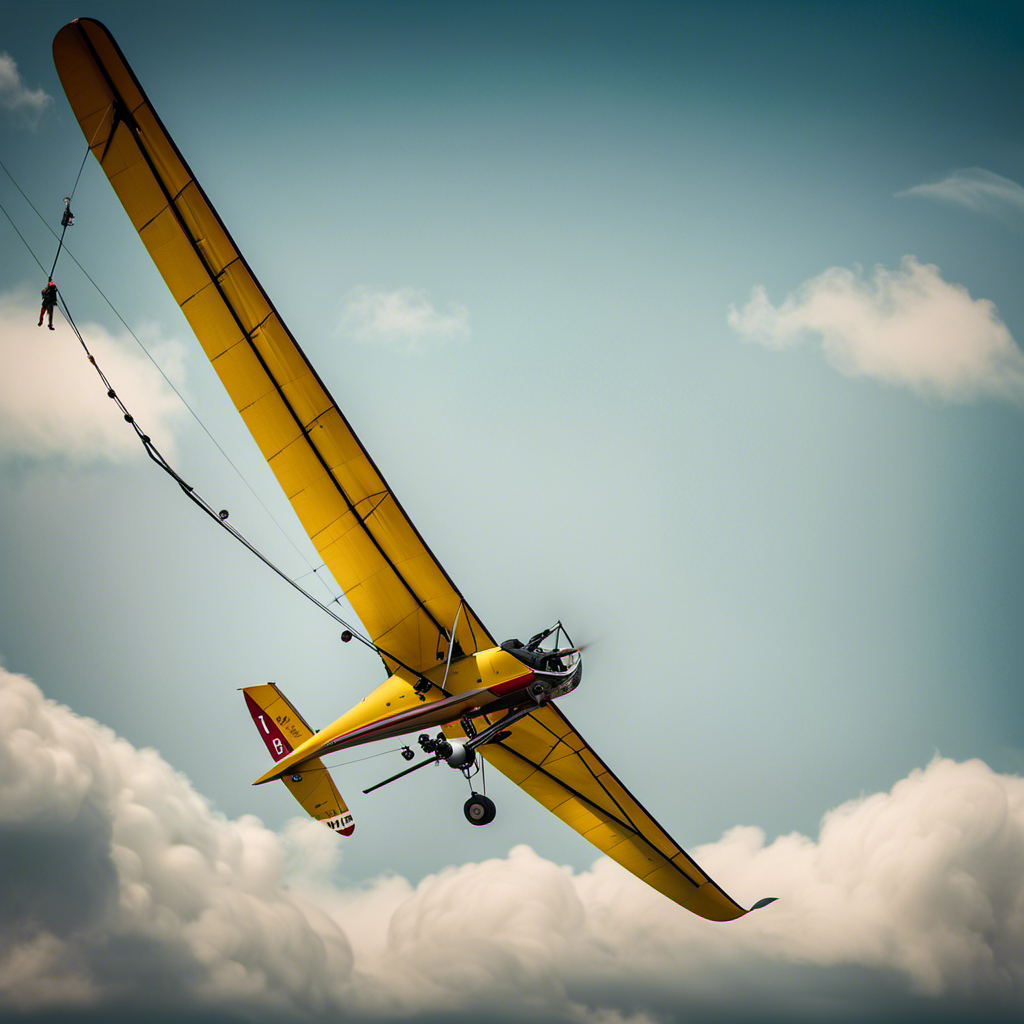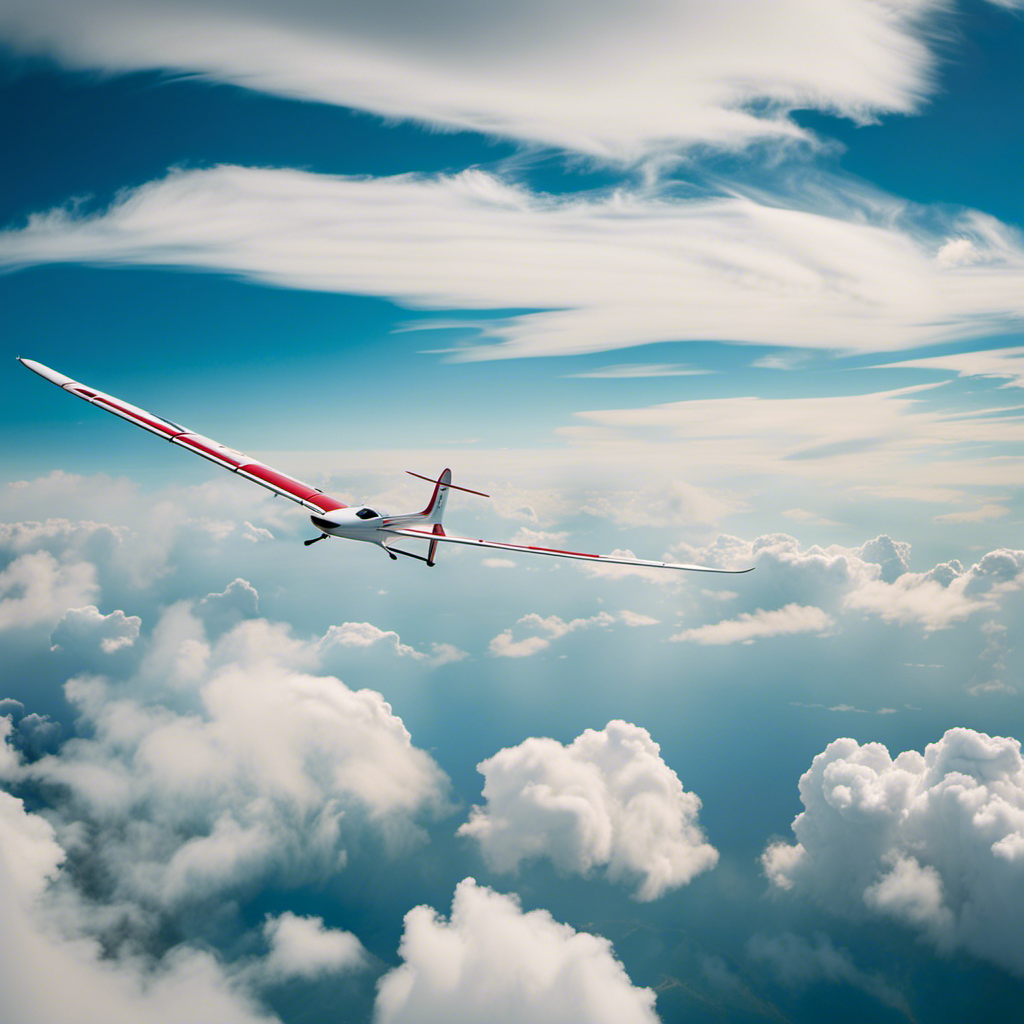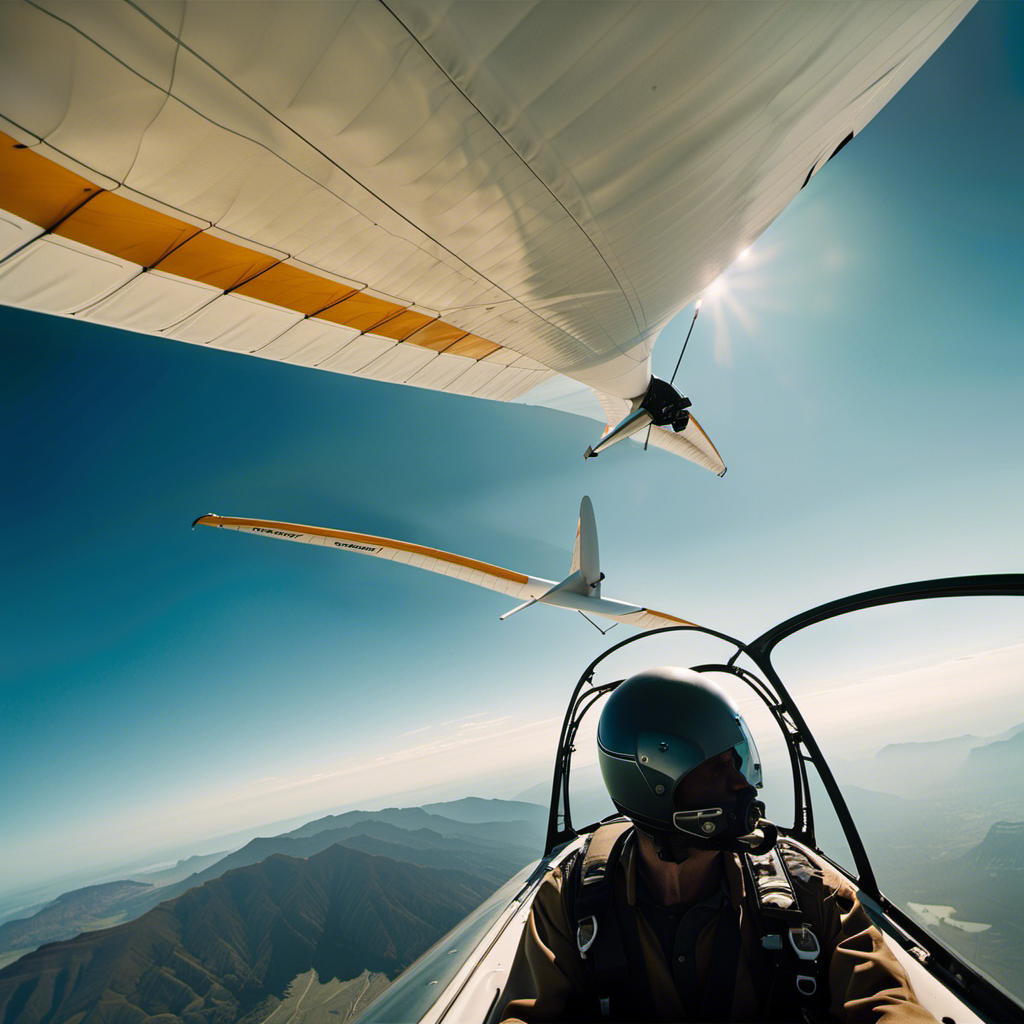As an aviator, I have always been fascinated by the intricacies of a winch launch.
Picture this: a powerful machine, propelling a glider into the sky with precision and force.
In this article, we will delve into the inner workings of winch launching, uncovering the physics behind it, exploring the process, and discussing the safety measures and considerations.
Join me as we unravel the advantages, limitations, and even the latest technological innovations in winch launching.
Get ready to soar to new heights of knowledge!
Key Takeaways
- Pulling down on the release lever disengages the tow rope from the glider.
- The winch release is crucial for the pilot to navigate independently.
- Regular inspections and maintenance of winch, tow rope, and associated equipment are crucial.
- Safety is paramount in winch launching.
The Basics of Winch Launching
Winch launching is a popular method used to launch gliders into the air. This technique involves using a ground-based winch to quickly and efficiently pull the glider into the sky. The equipment used for winch launching consists of a powerful winch, a strong cable, and a launch point with a sturdy anchor.
The winch is typically powered by an engine and is capable of generating a significant amount of force to propel the glider forward. However, there are some common mistakes that can occur during winch launching. These include improper cable tension, failure to release the cable at the right time, and not coordinating the glider’s pitch during the launch.
Understanding these potential pitfalls is crucial to ensuring a successful winch launch. Now let’s delve into the physics behind winch launching.
The Physics Behind Winch Launching
When it comes to winch launching, understanding the physics behind it is crucial.
Three key points to consider are:
- Tension and force: These factors play a significant role in determining the strength and stability of the cable during launch.
- Acceleration and velocity: These factors determine the speed at which the glider takes off.
- Aerodynamics and lift: These principles come into play, allowing the glider to overcome gravity and stay airborne.
Tension and Force
The tension in the winch cable increases as the force is applied to launch the glider. The winch cable is designed to withstand high levels of tension, ensuring a safe and efficient launch. Tension analysis is a crucial aspect of winch launching, as it allows us to measure and control the forces acting on the cable. By accurately measuring the tension, we can ensure that the cable is not overloaded and that the glider is launched with the appropriate force.
To measure the force during a winch launch, specialized force sensors are used. These sensors are capable of accurately detecting the force applied to the cable and providing real-time measurements. The force measurement data is then analyzed to ensure that it falls within safe operating limits.
Understanding the tension and force involved in a winch launch is essential for a successful and safe operation. It allows us to fine-tune the launch parameters and optimize the performance of the glider. With a thorough tension analysis and precise force measurement, we can confidently move into the next section, exploring the acceleration and velocity during the launch.
Acceleration and Velocity
You’ll experience a rapid increase in speed as the glider accelerates and gains velocity during the launch. The winch launch is a powerful method to get a glider off the ground.
The glider is connected to a cable, which is wound around a drum on the winch. As the winch is activated, the drum rotates, pulling the glider forward. The force from the winch creates an acceleration that propels the glider forward. This acceleration is greater than the force of gravity acting on the glider, allowing it to climb into the air.
The speed of the glider increases over time as the winch continues to pull the cable, providing a constant force. This speed vs time relationship is crucial for a successful launch. With enough acceleration and velocity, the glider can achieve the necessary lift to sustain flight.
Aerodynamics and Lift
To achieve lift and sustain flight, your glider relies on the principles of aerodynamics and the forces generated by the shape of its wings. The design of the glider plays a crucial role in its ability to generate lift. Here are three key factors in glider design that affect its aerodynamics and lift:
-
Wing shape: The wings of a glider are designed to generate lift by creating a pressure difference between the upper and lower surfaces. The shape of the wings, including the camber and wingtip design, greatly influences the lift generated.
-
Aspect ratio: The aspect ratio is the ratio of the wing’s span to its average chord. A higher aspect ratio allows for more efficient lift production and better glide performance.
-
Wing loading: Wing loading refers to the weight of the glider divided by its wing area. A lower wing loading results in a better lift-to-drag ratio and improved gliding capabilities.
Considering wind conditions is crucial for glider pilots. Factors such as wind speed, direction, and turbulence can affect the performance and handling of the glider. Understanding these conditions allows pilots to make informed decisions during flight.
Transitioning into the subsequent section about ‘the process of winch launching,’ we can now explore how these design principles come into play during the launch.
The Process of Winch Launching
When it comes to winch launching a glider, there are three key points to consider: hooking up the glider, launching the glider, and releasing the tow rope.
Firstly, the process begins with hooking up the glider to the tow rope, ensuring that all connections are secure and the tow hook is engaged.
Next, the glider is launched by the winch, which rapidly pulls in the tow rope, generating the necessary speed for takeoff.
Hooking Up the Glider
After securing the glider to the tow rope, the pilot can then prepare for takeoff. The glider connection is a critical step in the winch launch process. Here is how it works:
- The glider is positioned on the launch area, with the nose facing into the wind.
- The tow rope is attached to the glider’s release mechanism, ensuring a secure connection.
- The pilot ensures that all connections are properly fastened and double checks for any potential issues.
To ensure a smooth winch operation, the winch operator carefully controls the release of the tow rope. They maintain constant communication with the pilot, ensuring a synchronized launch.
With the glider securely connected and the winch ready, it’s time to move onto the next phase: launching the glider and soaring into the sky. The smooth connection between the glider and the tow rope sets the stage for a successful winch launch.
Launching the Glider
With the glider properly connected, I can now prepare for takeoff.
The launch of a glider is a critical moment that requires careful attention to glider performance and launch efficiency. The pilot must ensure that all controls are set correctly and that the glider is in the proper position for a successful launch.
This includes checking the airspeed indicator, ensuring that the wings are level, and verifying that the glider is balanced. By focusing on these details, I can maximize the glider’s performance during the launch and increase the efficiency of the entire process.
Once everything is ready, I will smoothly release the tow rope, allowing the glider to soar freely in the sky. Through this seamless transition, the tow rope becomes a thing of the past, and the glider is ready to explore the skies on its own.
Releasing the Tow Rope
To release the tow rope, simply pull down on the release lever and allow the glider to fly freely. The winch release is a vital component of the glider’s control system. It enables the pilot to disconnect from the tow rope once the desired altitude is reached.
Here’s how the process works:
-
Pull down on the release lever: This action disengages the tow rope from the glider, instantly disconnecting it from the winch.
-
Allow the glider to fly freely: Once released, the glider can soar through the air under its own power, using the energy gained during the winch launch.
The winch release is a crucial part of the glider’s control system, providing the pilot with the ability to detach from the tow rope and navigate independently. Safety measures and considerations must be carefully followed to ensure a successful and secure release.
Safety Measures and Considerations
Make sure you familiarize yourself with the safety measures and considerations involved in a winch launch. Safety is paramount in any aviation activity, and winch launching is no exception.
Before undertaking a winch launch, it is essential to have a thorough understanding of the emergency procedures and equipment maintenance. Regular inspections and maintenance of the winch, tow rope, and associated equipment are crucial to ensure their proper functioning and reliability.
In case of an emergency during the launch, such as a rope break or a sudden loss of power, pilots must be well-trained and prepared to react quickly and effectively. It is vital to have contingency plans in place and to regularly practice emergency procedures to maintain proficiency.
Now, let’s move on to discuss the advantages and limitations of winch launching.
Advantages and Limitations of Winch Launching
After discussing the safety measures and considerations involved in winch launching, it is important to explore the advantages and limitations of this method.
One of the main advantages of winch launching is its cost-effectiveness. Compared to other launching methods, such as aerotow or self-launching, winch launching requires less equipment and maintenance, making it a more affordable option. Additionally, winch launching allows for a quick turnaround time between launches, increasing the efficiency of operations.
However, there are limitations to winch launching as well. One major limitation is the dependency on suitable wind conditions. If the wind is too weak or too strong, it can be challenging to achieve a successful launch. Furthermore, winch launching requires a skilled operator who can accurately control the tension and speed during the launch.
Transitioning into the subsequent section, let’s now explore the innovations in winch launching technology.
Innovations in Winch Launching Technology
One of the latest innovations in winch launching technology is the development of automatic tension control systems. These systems are designed to provide precise and consistent tension control during the launch process, improving safety and efficiency.
With an electric winch and automated control, the tension can be adjusted automatically based on factors such as wind conditions, glider weight, and pilot preferences. This allows for a smoother and more controlled launch, reducing the risk of line breakages or sudden changes in tension.
The automated control also ensures that the tension is maintained at the optimal level throughout the launch, maximizing the performance of the winch and the glider.
Overall, the development of automatic tension control systems has greatly improved the winch launching process, making it safer and more reliable for glider pilots.
Frequently Asked Questions
What are the common types of winches used for launching gliders?
The common types of winch systems used for launching gliders include drum winches, capstan winches, and hydraulic winches. These winches offer various benefits such as rapid acceleration, high launch heights, and efficient retrieval operations.
Can a winch launch be performed in all weather conditions?
A winch launch cannot be performed in all weather conditions. Poor weather conditions such as strong winds, rain, or low visibility can greatly impact winch launch safety and make it unsafe to proceed.
How long does it typically take for a glider to reach its desired altitude during a winch launch?
During a winch launch, a glider typically reaches its desired altitude within a few minutes. The winch rapidly reels in a cable attached to the glider, pulling it upwards. The duration depends on factors such as glider weight and wind conditions.
Are there any specific weight or size limitations for gliders that can be launched using a winch?
Weight restrictions and safety considerations dictate the size and weight of gliders that can be launched using a winch. These limitations ensure optimal performance, stability, and the prevention of accidents during the launch process.
What is the recommended training and certification process for winch operators?
Recommended training for winch operators includes a comprehensive understanding of winch operations, safety protocols, and emergency procedures. Certification is typically obtained through a combination of theoretical coursework, practical training, and successful completion of written and practical exams.
Conclusion
In conclusion, the process of winch launching is a fascinating blend of physics, mechanics, and precision. By utilizing the power of a winch, gliders are able to achieve lift and take to the skies.
However, it is essential to remember the importance of safety measures and considerations in order to ensure a successful launch. While winch launching has its advantages, such as cost-effectiveness and flexibility, it also has limitations that need to be acknowledged.
Nevertheless, continual innovations in winch launching technology hold promise for the future of gliding.
With a heart that soars as high as the skies, Aria, affectionately known as “Skylark,” is the driving force behind Soaring Skyways. Her journey into the gliding world began as a young dreamer gazing up at the soaring birds, yearning to experience the weightlessness and freedom they embodied. With years of experience both in the cockpit and behind the scenes, Aria’s commitment to the gliding community is unwavering.










